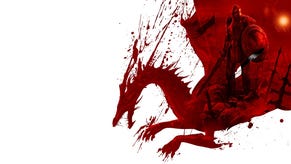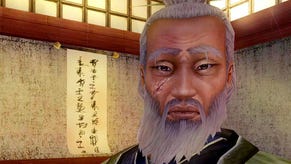Jade Empire
It's BioWare, Jim, but not as we know them...
A young, beautiful oriental girl strides confidently into an ancient Chinese teahouse, walking past tables occupied mostly by men who look suspiciously at her over their beverages. The soft lighting of the room gently illuminates her in silhouette, and drapes and banners flow around her as she brushes past them, seeking her enemies - who foolishly challenge her. Customers run for their lives as she slips out lethal looking twin swords and engages her rivals in a graceful display of martial arts prowess, the battle extending across the floor of the teahouse as blades flash, powerful punches and kicks are thrown in exotic combat styles, and even fantastical ice magic skills send unlikely freezing winds howling through the crevices of the beautiful building.
This isn't the latest stylish epic from a Chinese director, although flattering comparisons with Crouching Tiger, Hidden Dragon and Hero spring readily to mind as our beautiful heroine despatches her foes with flowing grace. In fact, this is our first glimpse of Jade Empire, the new game from legendary Canadian developers BioWare, whose affable co-founder, Dr. Ray Muzyka, is controlling the action for us. And what action; this is fast paced, high octane and a host of other such clichés which imply haste, not to mention being impressively graceful and well choreographed. But isn't this Bioware, the princes of the methodical, pause-focused combat system found in the likes of Baldur's Gate and Knights of the Old Republic? What's going on here, then?
Hero(ine)
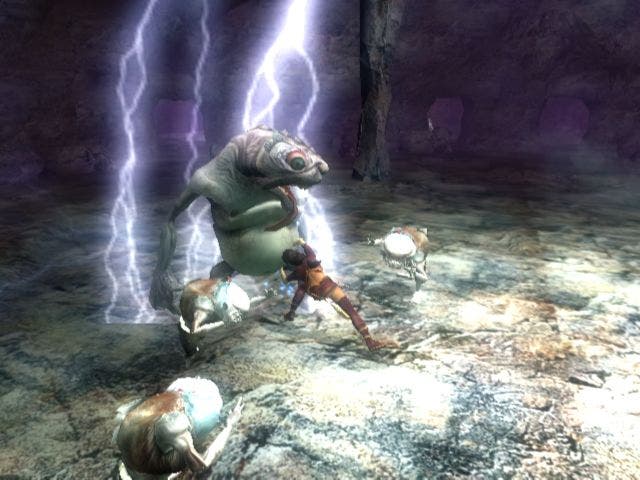
"All the combat in the game is all in real-time," Ray confirms, continuing to pummel his opponents into submission on-screen. "It's got a pretty deep system behind it. There are martial arts moves like Legendary Fist..." An unfortunate combatant is flung halfway across the room by a punch which certainly lives up to the name. "There are weapons like Double Sabres..." Our heroine lets out a bloodthirsty shout to ensure that everyone in the teahouse knows what she's about to cut them up with, and proceeds to slice an opponent like a sushi chef on a busy evening. "And magical styles like Ice Shard, which you can use to freeze enemies in place," he finishes, doing just that with a giant crystal of sparkling ice, and proceeding to pummel his hapless, frozen enemy into submission.
"Of course," he muses, "it's not much of a teahouse battle without having tables and chairs to smash." As if on cue, an enemy lands in the middle of a table, splintering it convincingly, while another unwillingly transforms a chair into matchsticks using only his ribcage. That's going to leave a bruise. "There's also a thing called Transformation Styles," Ray explains, while our heroine suddenly becomes a lot less sexy and a lot more bestial on screen, "where if you capture the spirit of certain types of monsters after they die, you can transform into them. That becomes a type of magical style. There are about a dozen of these transformation styles in the game."
"This one has various effects like setting enemies on fire." You guessed it - some unfortunate oriental lackey is currently running around with smoke pouring out of his topknot, and his underpants for that matter. It looks unpleasant. We're starting to feel a little sorry for our opponents at this stage; if there's one thing worse than being beaten senseless by a little girl, it's being beaten senseless in a variety of interesting and painful ways by a little girl who is clearly just showing off.
"Let me show you some more things about Ice Shard style as well," Ray says, clearly not sharing our sympathy for the unfortunate henchmen being so ruthlessly shamed on screen. "I can turn on armour - so now enemies that attack me will actually take Ice damage. I can also cause a snowstorm to appear in the area, so all of the enemies in the area start taking freezing damage." Armour is particularly impressive, with a covering of ice flowing over the player's body and defending against enemy strikes, while later on Ray also demonstrates fire armour - a similar concept, but with flickering flames engulfing anyone daft enough to lay a finger on you. And presumably providing helpful thermal underwear-style insulation as a side-benefit.
Teahouse of flying daggers
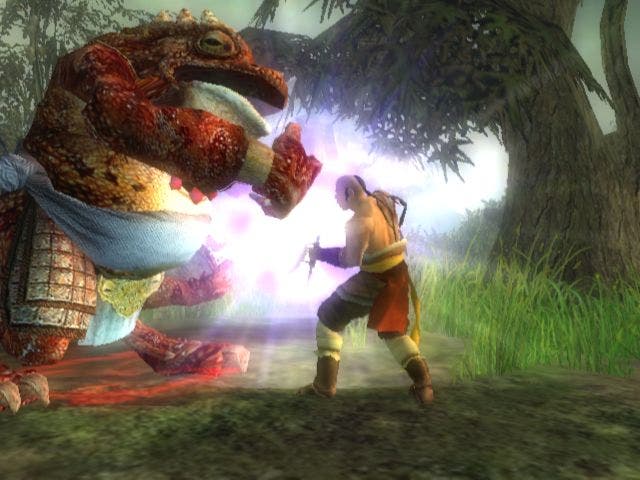
That's all very well - and believe us, when you see it in action, it really is all very well indeed, leaving us fighting the urge to wrest the controller from Ray's grip and try landing some punches ourselves - but it still doesn't quite answer the question: what's going on? This is BioWare's first effort at creating an original title - their previous games were always based on other people's franchises - and it seems that the company has made a definite effort to break out of the RPG mould. Or has it?
"It's quite different from what we've done before in terms of the combat," Ray says, as the walls of the teahouse shake from the somewhat pissed-off roar of the demonic boss, who has emerged to find out what the bloody racket is and found a young lass standing in the middle of a pile of his utterly useless footsoldiers. "The storylines though, and the character interactions, the exploration and the progression of the characters is very similar to what we've done with past games."
"The common thread for us, between this and our past games, is that they have a story where you could have good and evil storylines, a non-linear, branching story path, character progression where you get meaningful rewards, character interaction where we really try to improve the artform of the virtual actor, and exploration where you get to explore new areas," he says.
"Now the new thing on top of that is the real-time martial arts action combat. We felt that was the right thing to do for a game like this, where really it's about you becoming a martial arts master. We wanted it to feel like you become that, and we thought that the way to do that was to make it really tactile and rich in terms of the way the combat felt."
On screen, our heroine is running rings around the teahouse boss, aided somewhat by the fact that she's slowed down time for everyone apart from herself - a technique called Focus, apparently, which is triggered by the Y button and relies on you replenishing your stocks of focus points by defeating enemies. She runs out of Focus rapidly, though, and backs off, wary of the beast's lethal strikes. They circle for a while, showing off the Zelda-style combat lock-on mode, and then she strikes; freezing the beast in place with her Ice Shard style before switching to Double Sabres to slice off some bacon. It's all over.
"In terms of the combat...." Ray thinks for a moment. "I guess you could take a very thoughtful approach to it, so if you want to choose which style you're in while you're paused, you can do that, or choose which enemy you're targeting, decide what to do next and then unpause. But in terms of what the effects are, it's basically button press equals action. There are basically three different ways to play, I guess. One is to pause the game, and really think about what your next action is. The second way is to just play on in real-time, and the third way is to actually turn off targeting, so you move around and attack enemies on the fly."
Crouching Tiger Claw, Hidden Fire Dragon
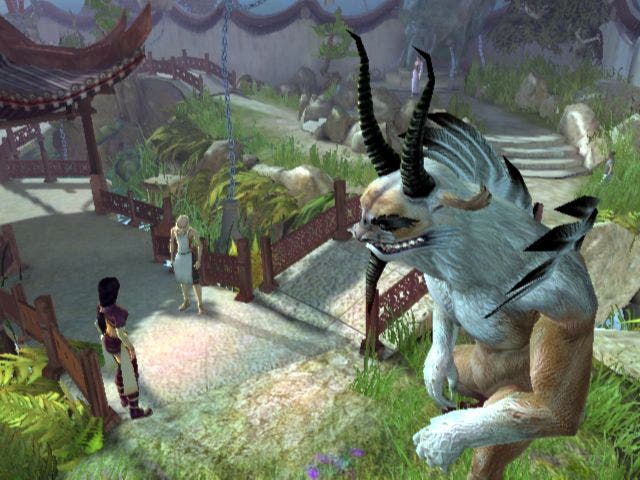
Teleported into a new area, our heroine finds herself battling toad demons and elephant demons in the grounds of an ancient temple. Outdoors for the first time, we suddenly appreciate how stunningly beautiful the game is, with amazing environments all lovingly textured and illuminated with a soft lighting system which employs complex and relatively rarely-seen techniques such as over-brightness and rim-lighting to stunning effect. Ray continues to thrash his foes, albeit with a little more difficulty this time, as he explains to us a bit more about that combat system.
"Every character can learn all of the 30 fighting styles - or some of them anyway, you don't have to learn all of them. Most players probably won't learn everything," he says. On-screen, a giant fire dragon is summoned to fight alongside him, instantly immolating a toad demon in the process - a high level technique from the fiery compatriot to the Ice Shard fighting style. Other styles we're given a brief look at include the dazzlingly fast Double Ring style and the powerful, flexible Tiger Claw style - but with thirty styles in the game, each with its unique moves and powers, it's obvious that we're only seeing a tiny sub-set of what's on offer.
What's more, each style can be levelled up independently. "These are all higher level effects," Ray tells us, engaging his burning Fire Armour and setting the dragon on a small group of unhappy looking evil elephants. "As you gain levels, you get style progression points which you put into the different styles, and level them up to get new effects. You choose which styles you want to level up."
"It's quite a deep reward system actually - it provides a lot of meaningful changes to the player, and a lot of opportunities to create a very different gameplay experience," he explains. Fans of BioWare's previous RPGs who might be a bit concerned by this new-fangled real-time nonsense should take solace from these words. The team has no intention of abandoning their core fanbase with the move towards an action title - they're still all about depth, and the branching storylines and uniquely customisable gameplay we've come to expect from BioWare games are present and correct in Jade Empire.
"It's an action RPG, so we wanted to blend the features of action games and role-playing games," says Ray, "but it is an RPG still, at its core. It's got action elements, so it should appeal to action fans too - we think it'll draw in a whole new audience, who'll hopefully be attracted to this."
Good, Evil and Kung Fu
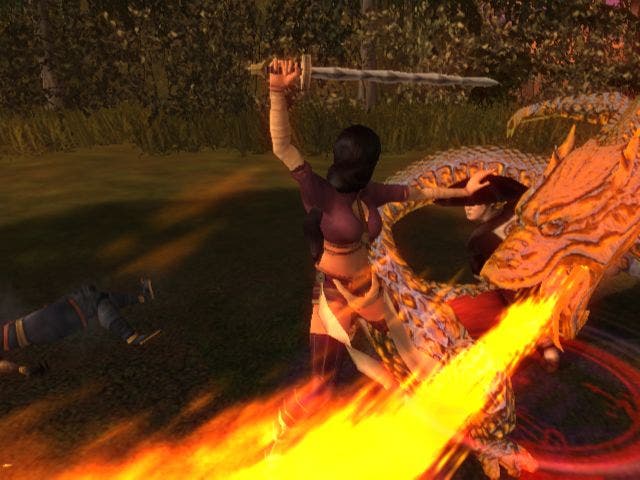
Although the artwork for the game has shown off a number of different characters, you don't play as a variety of characters over the course of the game. Instead, you spend the entire playtime - around twenty to thirty hours, with more for the side quests - building up one central character. "You take one character and play through the game - but if you replay the game as another character, it'll be slightly different, because there are people who'll recognise that character and have certain sub-quests available for that character only," Ray tells us. "Also, depending on whether you choose to be good or evil, the game will play differently, and it'll play differently depending on which fighting styles you choose - so there's a lot of replayability in there."
As he explains this, we've moved location once more - this time standing in a snowy hilltop fortress in the Land of Hallowed Spirits, which is modelled after Tibet and features a unique architectural style as well as a quite different environment - all snow and mist, with beautifully animated flags and pennants flapping limply in the wind over the domed buildings. Our character this time around, a strapping young lad with an aversion to shirts, doesn't look cold, but we swear, he'll catch his death. If not from a cold, then from the giant golem which is marching on the town gates...
Good or evil, eh? Yes, that's a choice that's very much open to you, just as it was in Knights of the Old Republic - and the effects on your character and on how the game plays will be significant. "There are consequences," Ray warns. "If you're evil, there are consequences to that - people won't like you, they won't want to work with you. Some martial arts masters may not want to teach you... Of course, there are others who'll only want to teach you if you're evil."
All aboard the Orient Express
Comparisons between Jade Empire and the excellent Fable are inevitable, of course, but in reality this looks like quite a different type of game. The combat is far superior to what's on offer in Fable, while the game is much more driven by its storyline (which we've only caught brief glimpses of, but which is bound to be excellent, based on BioWare's past record) rather than by Fable's unique hook of character customisation and world interaction. One thing is certain - Jade Empire is one of the most stunningly beautiful games the Xbox has ever seen, and it's one of the most intriguing prospects in the pipeline for the system, jumping easily to the top of our most-wanted list. Well, okay, to second place after Halo 2. But... all of BioWare's formidable creative power, combined with a stunning real-time combat system, and an Oriental fantasy world realised with painstaking detail? If it's even half as good as it sounds, it'll be one of the best games on the system. We'll know for certain when the game, now apparently feature-complete, arrives in the first quarter of 2005.


